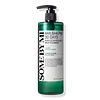Aromatica Pure & Soft Feminine Wash Versus Some By Mi AHA BHA PHA 30 Days Miracle Acne Clear Body Cleanser
What's inside
What's inside
 Key Ingredients
Key Ingredients

No key ingredients
 Benefits
Benefits

 Concerns
Concerns

 Ingredients Side-by-side
Ingredients Side-by-side

Taraxacum Officinale Rhizome/Root Extract
Skin ConditioningLonicera Japonica Flower Extract
Skin ConditioningAloe Barbadensis Leaf Extract
EmollientWater
Skin ConditioningDiglycerin
HumectantCoco-Betaine
CleansingSodium Sweetalmondamphoacetate
CleansingSodium Chloride
MaskingPropanediol
SolventEthylhexylglycerin
Skin ConditioningGlycerin
HumectantLactic Acid
BufferingChamomilla Recutita Flower Extract
MaskingRosmarinus Officinalis Leaf Extract
AntimicrobialVerbena Officinalis Extract
EmollientMaltodextrin
AbsorbentTaraxacum Officinale Rhizome/Root Extract, Lonicera Japonica Flower Extract, Aloe Barbadensis Leaf Extract, Water, Diglycerin, Coco-Betaine, Sodium Sweetalmondamphoacetate, Sodium Chloride, Propanediol, Ethylhexylglycerin, Glycerin, Lactic Acid, Chamomilla Recutita Flower Extract, Rosmarinus Officinalis Leaf Extract, Verbena Officinalis Extract, Maltodextrin
Water
Skin ConditioningLauric Acid
CleansingGlycerin
HumectantPotassium Hydroxide
BufferingMyristic Acid
CleansingSodium Chloride
MaskingSodium C14-16 Olefin Sulfonate
CleansingLauryl Hydroxysultaine
CleansingBenzyl Glycol
SolventCoco-Betaine
CleansingSalicylic Acid
MaskingEucalyptus Globulus Leaf Oil
PerfumingButylene Glycol
HumectantEthylhexylglycerin
Skin ConditioningMelia Azadirachta Leaf Extract
Skin ConditioningDisodium EDTA
Coptis Japonica Root Extract
Skin Conditioning1,2-Hexanediol
Skin ConditioningMelia Azadirachta Flower Extract
Skin ConditioningMelaleuca Alternifolia Leaf Water
AntimicrobialEthyl Hexanediol
SolventCentella Asiatica Extract
CleansingAsiaticoside
AntioxidantMadecassic Acid
Skin ConditioningGluconolactone
Skin ConditioningCitric Acid
BufferingAsiatic Acid
Skin ConditioningMandelic Acid
AntimicrobialMadecassoside
AntioxidantArtemisia Vulgaris Extract
Skin ConditioningWater, Lauric Acid, Glycerin, Potassium Hydroxide, Myristic Acid, Sodium Chloride, Sodium C14-16 Olefin Sulfonate, Lauryl Hydroxysultaine, Benzyl Glycol, Coco-Betaine, Salicylic Acid, Eucalyptus Globulus Leaf Oil, Butylene Glycol, Ethylhexylglycerin, Melia Azadirachta Leaf Extract, Disodium EDTA, Coptis Japonica Root Extract, 1,2-Hexanediol, Melia Azadirachta Flower Extract, Melaleuca Alternifolia Leaf Water, Ethyl Hexanediol, Centella Asiatica Extract, Asiaticoside, Madecassic Acid, Gluconolactone, Citric Acid, Asiatic Acid, Mandelic Acid, Madecassoside, Artemisia Vulgaris Extract
 Reviews
Reviews

Ingredients Explained
These ingredients are found in both products.
Ingredients higher up in an ingredient list are typically present in a larger amount.
Coco-Betaine is the natural version of Cocamidopropyl Betaine. It is often derived from coconuts.
Coco-Betaine is a surfactant, meaning it helps remove dirt and oil from the skin.
Ethylhexylglycerin (we can't pronounce this either) is commonly used as a preservative and skin softener. It is derived from glyceryl.
You might see Ethylhexylglycerin often paired with other preservatives such as phenoxyethanol. Ethylhexylglycerin has been found to increase the effectiveness of these other preservatives.
Glycerin is already naturally found in your skin. It helps moisturize and protect your skin.
A study from 2016 found glycerin to be more effective as a humectant than AHAs and hyaluronic acid.
As a humectant, it helps the skin stay hydrated by pulling moisture to your skin. The low molecular weight of glycerin allows it to pull moisture into the deeper layers of your skin.
Hydrated skin improves your skin barrier; Your skin barrier helps protect against irritants and bacteria.
Glycerin has also been found to have antimicrobial and antiviral properties. Due to these properties, glycerin is often used in wound and burn treatments.
In cosmetics, glycerin is usually derived from plants such as soybean or palm. However, it can also be sourced from animals, such as tallow or animal fat.
This ingredient is organic, colorless, odorless, and non-toxic.
Glycerin is the name for this ingredient in American English. British English uses Glycerol/Glycerine.
Learn more about GlycerinChances are, you eat sodium chloride every day. Sodium Chloride is also known as table salt.
This ingredient has many purposes in skincare: thickener, emulsifier, and exfoliator.
You'll most likely find this ingredient in cleansers where it is used to create a gel-like texture. As an emulsifier, it also prevents ingredients from separating.
There is much debate on whether this ingredient is comedogenic. The short answer - comedogenic ratings don't tell the whole story. Learn more about comegodenic ratings here.
The concensus about this ingredient causing acne seems to be divided. Research is needed to understand if this ingredient does cause acne.
Scrubs may use salt as the primary exfoliating ingredient.
Learn more about Sodium ChlorideWater. It's the most common cosmetic ingredient of all. You'll usually see it at the top of ingredient lists, meaning that it makes up the largest part of the product.
So why is it so popular? Water most often acts as a solvent - this means that it helps dissolve other ingredients into the formulation.
You'll also recognize water as that liquid we all need to stay alive. If you see this, drink a glass of water. Stay hydrated!
Learn more about Water